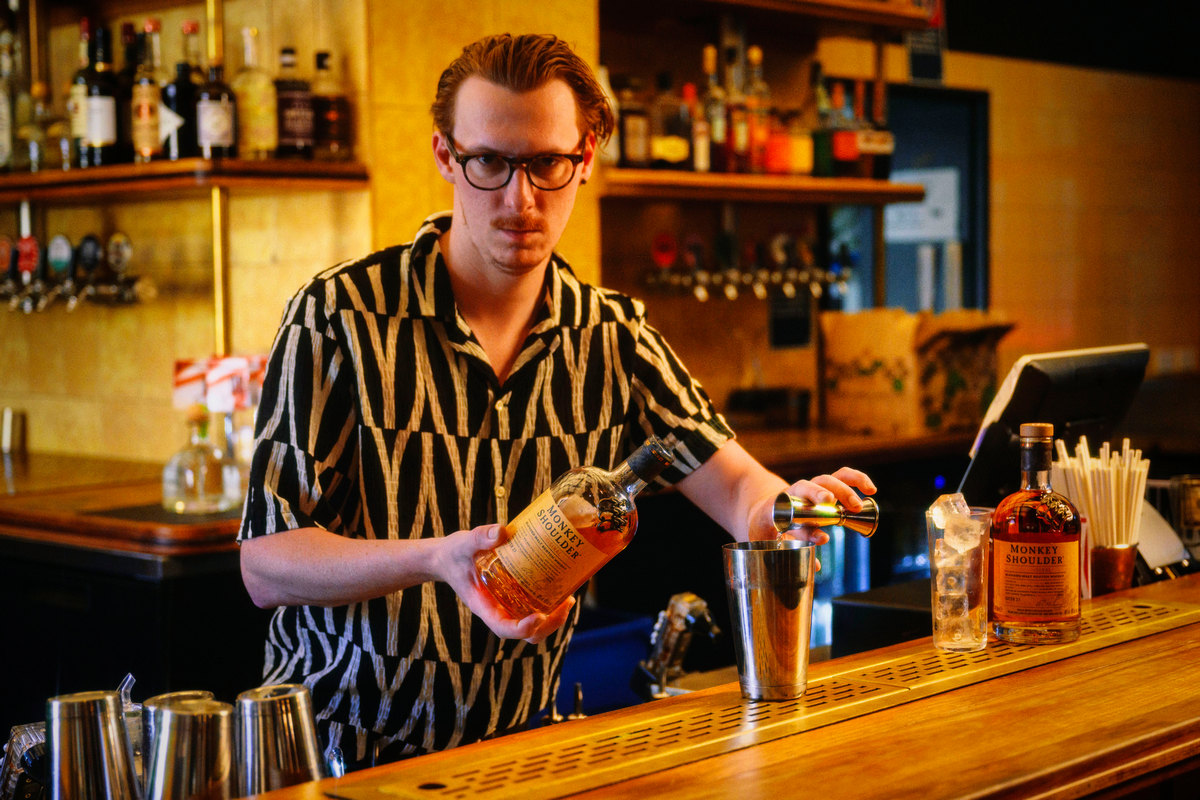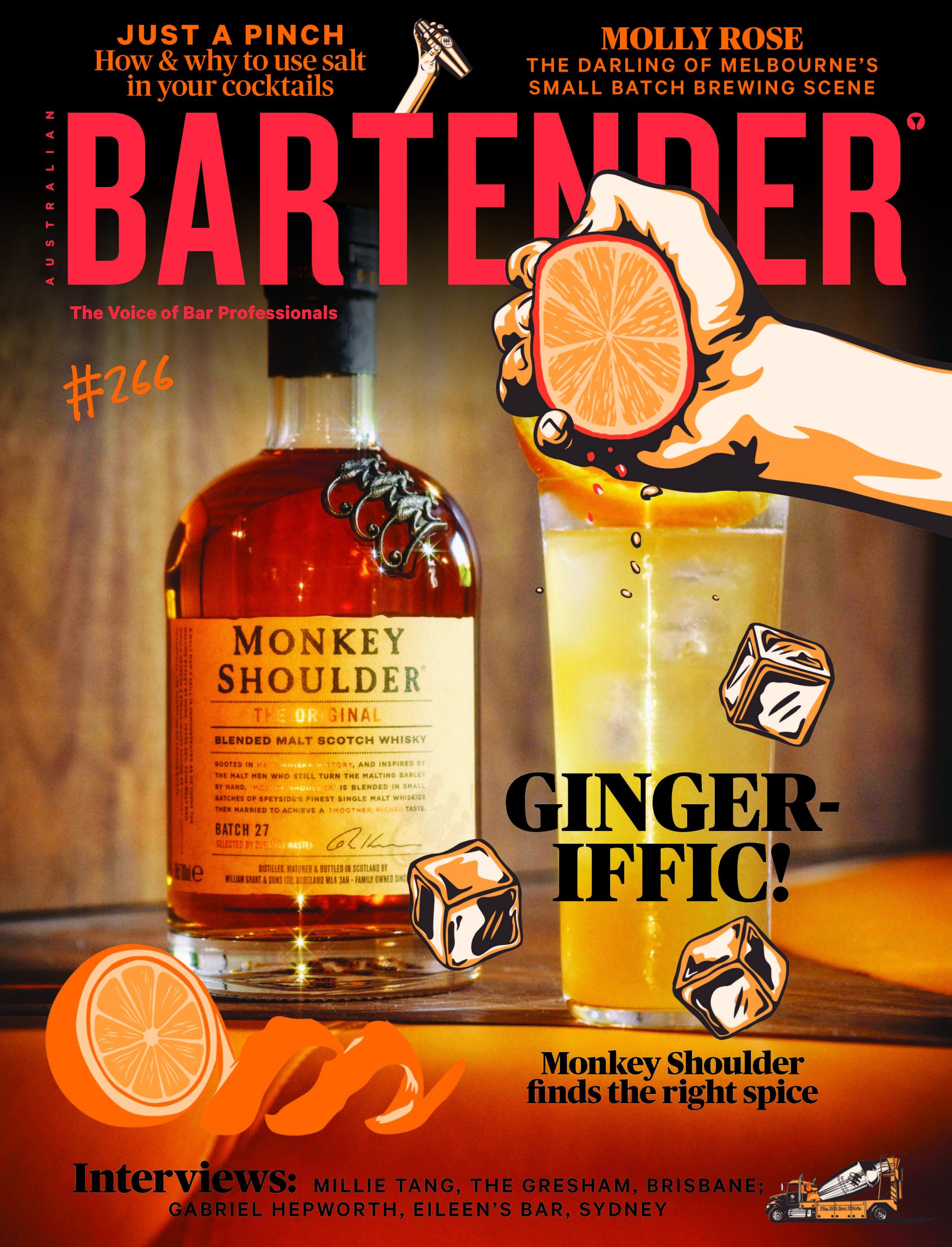 Story by Mikey Lowe, Brand Manager, Monkey Shoulder.
Story by Mikey Lowe, Brand Manager, Monkey Shoulder.
Photography by Christopher Pearce with Rusty Russell at The Abercrombie Hotel.
Under the guise of many names, the simplicity of the ginger highball sometimes lacks lustre beside its contemporaries. A simple recipe; whisky with a long pour of ginger ale, but with this simplicity, there is an emphasis on its ingredients. This recipe comprises whisky, always Scotch whisky, mixed with ginger, chilled, diluted with quality ice, and set with citrus crown thus forming a gestalt entity.
Whilst we tackle heated questions unearthing the root of the Ginger Monkey, Monkey Shoulder’s playful take on the highball, we suggest you turn to your wet bar and mix yourself a refresher made with ginger.
 Rooted in Eastern medicine, ginger is embedded in Indian and Chinese culture. Reducing bloat, inflammation and other ailments of the body and mind, ginger found success and a home as a spicy additive to Asiatic cuisines. This rhizome matured in value as it embarked along trade routes of the Roman Empire – a mere pound of ginger would cost you a sheep. Ginger was common amongst apothecaries by the fall of this empire and the rise of a new one, Britain. These were ‘Witchdoctor brews’ until a ferment was created in Yorkshire in the 1700s. By mixing a mash of ginger, sugared water, and lemon or cream of tartar, an alcoholic ginger beer was born. Soon thereafter spirits were being added.
Rooted in Eastern medicine, ginger is embedded in Indian and Chinese culture. Reducing bloat, inflammation and other ailments of the body and mind, ginger found success and a home as a spicy additive to Asiatic cuisines. This rhizome matured in value as it embarked along trade routes of the Roman Empire – a mere pound of ginger would cost you a sheep. Ginger was common amongst apothecaries by the fall of this empire and the rise of a new one, Britain. These were ‘Witchdoctor brews’ until a ferment was created in Yorkshire in the 1700s. By mixing a mash of ginger, sugared water, and lemon or cream of tartar, an alcoholic ginger beer was born. Soon thereafter spirits were being added.
By mixing a mash of ginger, sugared water, and lemon or cream of tartar, an alcoholic ginger beer was born. Soon thereafter spirits were being added.
The tide turned with an Irish apothecary, Thomas Joseph Cantrell, who manufactured the first ginger ale in Belfast in the 1850s, but it was Canadian pharmacist, John McLaughlin, who invented the modern processed ginger ale in 1907, Canada Dry, by combining carbonated water mixed with fruit juices and flavourings. McLaughlin sold his tonic to soda jerks across North America to wild success. The opaque and fiery ginger beer may still yet have trumped its cousin, the ale, were it not for the rising tide of temperance. Due to ginger beer’s residual alcohol content, ginger ale took centre stage amidst the moral crisis sweeping North America.
 Countless iterations of the same cocktail were lost to the ages since the repeal. Whether patrons call for a Mamie Taylor, a Presbyterian, a Whisky Buck, or a Whisky Mule, we can’t understate how all these drinks share as a ginger highball with minor modifications.
Countless iterations of the same cocktail were lost to the ages since the repeal. Whether patrons call for a Mamie Taylor, a Presbyterian, a Whisky Buck, or a Whisky Mule, we can’t understate how all these drinks share as a ginger highball with minor modifications.
Backbars buckle with whisky options, a modern choice for premium mixers flourish, and the abundance of quality ice is snow joke.
How do you make these decisions? We ask four ginger aficionados for their hot take on ginger and this ginger-iffic whisky highball.
Rusty Russell (Beverage Manager at The Abercrombie Hotel): “Ginger has a lot of versatility. We all know that iconic ginger ‘spice’ (pun intended) but when using fresh, the age when picked can make a huge difference in flavour. If you decide to juice it, or create a tincture, ginger can create a range of different experiences. A touch of ginger on your winter menu is always warming.”
Ed Sheerun (not the one you’re thinking of, this one is a sheep shearer turned bartender): “For me, the choice of ginger ale or ginger beer depends on the spirit. Esterific rums can handle ginger beer’s intensity, but ginger ale obliges whisky’s vanilla, spice and malt flavours which meld effortlessly with the sweetness and subdued fire of the ginger.
Gerry Halliwell (again, not the one you’re thinking of – she’s a DJ who likes a bit of spice in her mixes): “Its all a balancing act. The right mix needs the bass (Monkey Shoulder), the treble (Ginger Ale), and the melody (ice and dilution). But it’s that something extra that tops it off, where adding a slice of orange invites complement”.
Finally, we asked Chuck Norris (… if you have to ask): “If whisky on ice is very nice and causes you a great ballyhoo at the thought of tainting your tipple, just remember, Fred Astaire was great, but Ginger Rogers did everything he did, backwards … and in high heels.”
Whether you mix with ginger beer or ginger ale, we think a cheer be given to the other in your drink.
Ginger Facts You Can Tell at The Bar:
-
- Ginger is a rhizome, meaning an underground stem, not a root.
- Eastern Medicine has been creating ginger tonic to cure ailments for over 5000 years
- Ginger is an analgesic and can reduce the activity of several substances which promote inflammation
- ‘Ginger’ Cockney Rhyming Slang for an engineer
- LGBTQ online community ‘Gingerbeer’ got its name from an alternate translation of Cockney rhyming slang for ‘queer.
 This story featured in the May edition of Australian Bartender magazine. The May edition is landing now.
This story featured in the May edition of Australian Bartender magazine. The May edition is landing now.

